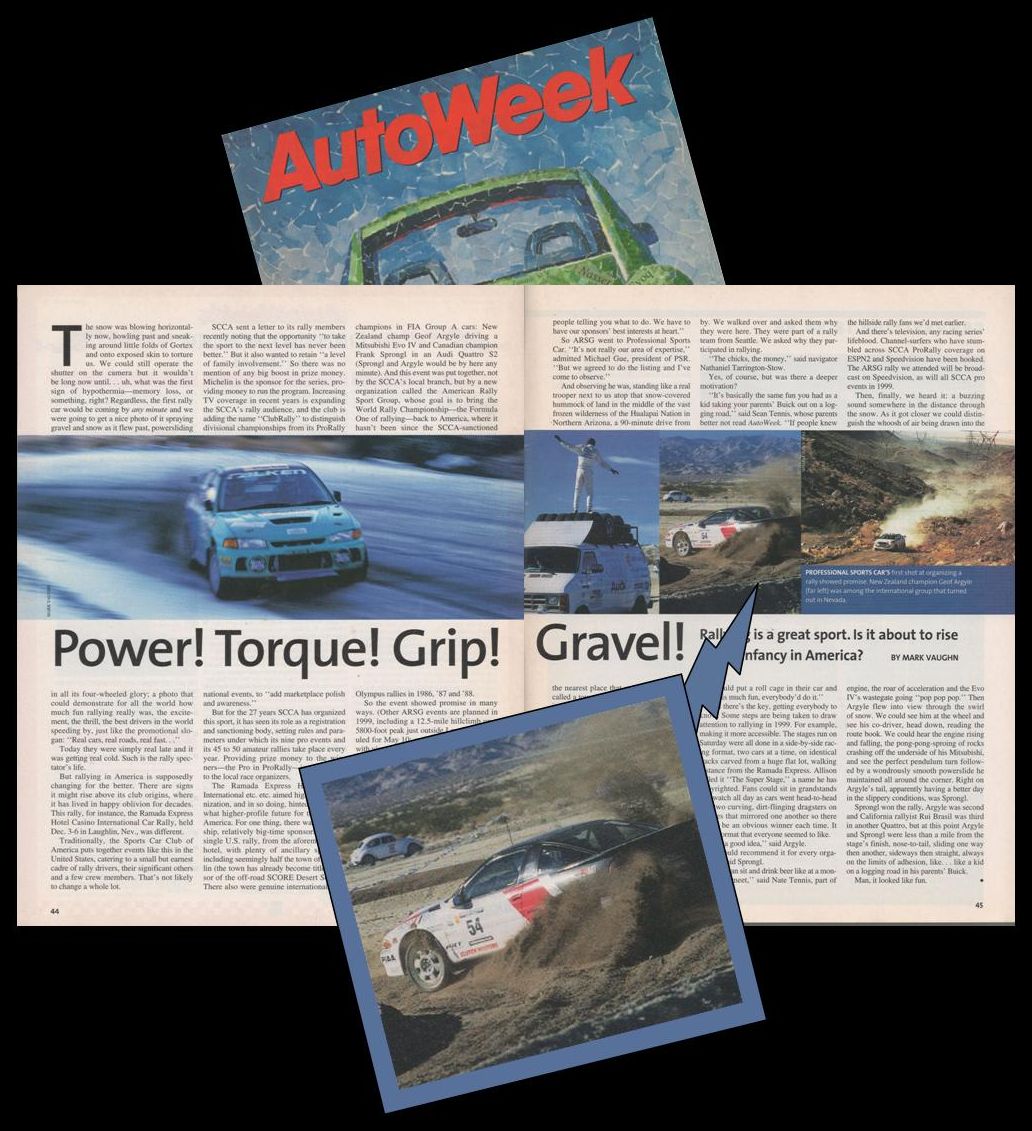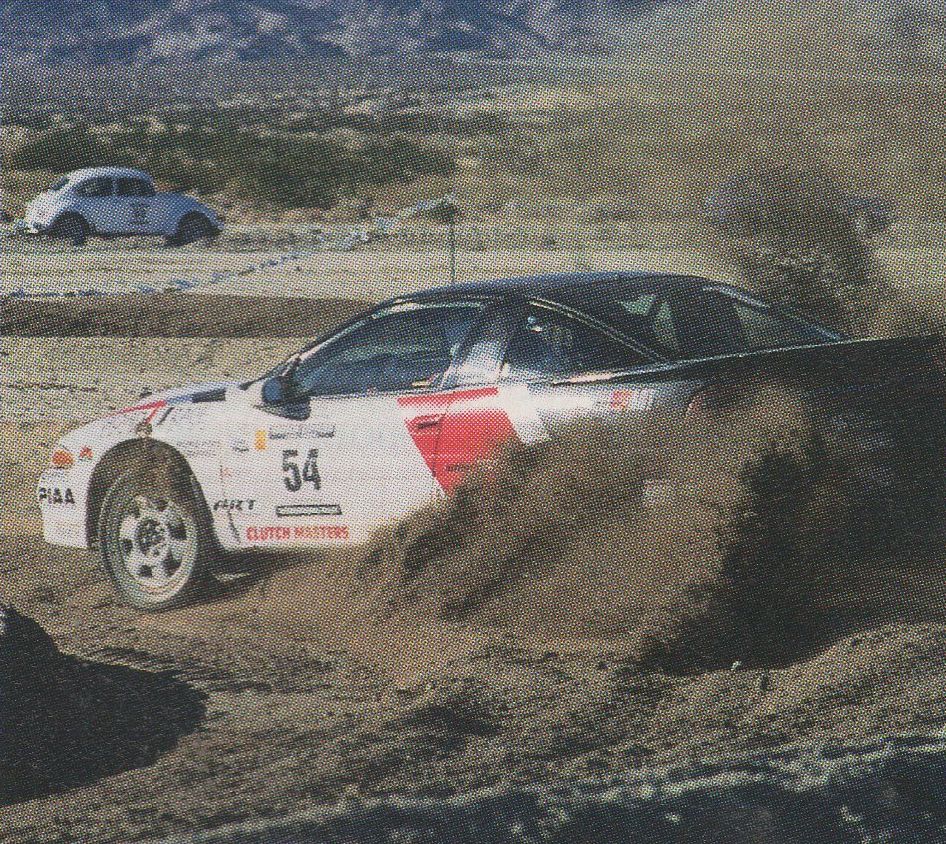Laughlin Rally – Robert Garcia Gets his Eclipse in Autoweek!
We just got back from the Rally America Pro Rally. Robert Garcia from the shop here ran his Eclipse GS-T in Open 2WD class. Along with Tony Chavez, Paul Timmerman and Doug Robinson we froze out butts chasing and fixing rally cars from Laughlin to the the Grand Canyon and back over 3 days. Autoweek magazine came in the mail and along with a great article about the rally and rallying in general, we were treated to a pick of Robert’s GS-T throwing a sweet rooster tail up.
Autoweek Magazine – December 28, 1998
Rallying is a great sport. Is it about to rise out of infancy in America?
BY MARK VAUGHN
The snow was blowing horizontally now, howling past and sneaking around little folds of Gortex and onto exposed skin to torture us. We could still operate the shutter on the camera but it wouldn’t be long now until. . . uh, what was the first sign of hypothermia memory loss, or something, right? Regardless, the first rally car would be coming by any minute and we were going to get a nice photo of it spraying gravel and snow as it flew past, powersliding in all its four-wheeled glory; a photo that could demonstrate for all the world how much fun rallying really was, the excitement, the thrill, ‘the best drivers in the world speeding by, just like the promotional slogan: ~Real cars, real roads, real fast. . .”
Today they were simply real late and it was getting real cold. Such is the rally spectator’s life. But rallying in America is supposedly changing for the better. There are signs it might rise above its club origins, where it has lived in happy oblivion for decades. This rally, for instance, the Ramada Express Hotel Casino International Car Rally, held Dec. 3-6 in Laughlin, Nev., was different. Traditionally, the Sports Car Club of America puts together events like this in the United States, catering to a small but earnest cadre of rally drivers, their significant others and a few crew members. That’s not likely to change a whole lot.
SCCA sent a letter to its rally members recently noting that the opportunity “to take the sport to the next level has never been better.” But it also wanted to retain “a level of family involvement.” So there was no mention of any big boost in prize money. Michelin is the sponsor for the series, providing money to run the program. Increasing TV coverage in recent years is expanding the SCCA’s rally audience, and the club is adding the name “ClubRally” to distinguish divisional championships from its ProRally national events, to “add marketplace polish and awareness.”
But for the 27 years SCCA has organized this sport, it has seen its role as a registration and sanctioning body, setting rules and parameters under which its nine pro events and its 45 to 50 amateur rallies take place every year. Providing prize money to the winners-the Pro in ProRally-is mostly left to the local race organizers.
The Ramada Express Hotel Casino International etc. etc. aimed high in its organization, and in so doing, hinted at a somewhat higher-profile future for the sport in America. For one thing, there was sponsorship, relatively big-time sponsorship for a single U.S. rally, from the aforementioned hotel, with plenty of ancillary sponsors, including seemingly half the town of Laughlin (the town has already become title sponsor of the off-road SCORE Desert Series).
There also were genuine international rally champions in FIA Group A cars: New Zealand champ Geof Argyle driving a Mitsubishi Evo IV and Canadian champion Frank Sprongl in an Audi Quattro S2 (Sprongl and Argyle would be by here any minute). And this event was put together, not by the SCCA’s local branch, but by a new organization called the American Rally Sport Group, whose goal is to bring the
World Rally Championship-the Formula One of rallying-back to America, where it hasn’t been since the SCCA-sanctioned Olympus rallies in 1986,’87 and ’88.
So the event showed promise in many ways. (Other ARSG events are planned in 1999, including a 12.5-mile hillclimb up a 5800-foot peak just outside Laughlin scheduled for May 10; and a Motorsports Week, with vintage racing on an airport road course across the river from Laughlin, a concours and another rally all in the same weekend, in November or December.)
To get the FIA sanction for this first race, ARSG had to go through an FIA-sanctioned race organizer. SCCA would have been the logical choice.
“We were doing some things differently from what they do, like adding a vintage class and an SUV c1ass,” said Roger Allison, the main guy behind ARSG and this Laughlin rally. Plus, SCCA would want television rights and the photo rights. But it comes down to the fact that we’re a for-profit corporation, not a club. You can’t have people telling you what to do. We have to have our sponsors’ best interests at heart.”
So ARSG went to Professional Sports Car. “It’s not really our area of expertise,” admitted Michael Gue, president of PSR. “But we agreed to do the listing and I’ve come to observe.”
And observing he was, standing like a real trooper next to us atop that snow-covered hummock of land in the middle of the vast frozen wilderness of the Hualapai Nation in Northern Arizona. a 90-minute drive from the nearest place that could reasonably be called a town, contemplating frostbite, waiting for that first car.
“One can certainly see the traditional obstacles faced by rally organizers in assembling a spectator base,” said Gue, as snow accumulated on his new suede wingtips, an unfortunate footwear choice. Recruiting spectators is not a problem in Europe and the rest of the world (see page 1 1), where rally fans actually enjoy standing around for hours so Colin McRae can almost hit them with his Subaru.
“Back home it’s our biggest sport,” Argyle said. “We’ll get 250,000 spectators at an event. We’ll get people who will go out in anything.”
Here in the desert, we were 249,994 short of that number, counting Gue and us. The other four guys were perched on a cactus-covered hillside a half-mile away, bundled against the cold waitino for the cars to come by. We walked over and asked them why they were here. They were part of a rally team from Seattle. We asked why they participated in rallying.
“The chicks, the money,” said navigator Nathaniel Tarrington-Stow. Yes, of course, but was there a deeper motivation?
“It’s basically the same fun you had as a kid taking your parents’ Buick out on a logging road,” said Sean Tennis, whose parents better not read AutoWeek. “If people knew they could put a roll cage in their car and have this much fun, everybody’d do it.” And there’s the key, getting everybody to know. Some steps are being taken to draw attention to rallying in 1999. For example, making it more accessible. The stages run on Saturday were all done in a side-by-side racing format, two cars at a time, on identical tracks carved from a huge flat lot, walking distance from the Ramada Express. Allison called it “The Super Stage,” a name he has copyrighted. Fans could sit in grandstands and watch all day as cars went head-to-head like two curving, dirt-flinging dragsters on courses that mirrored one another so there would be an obvious winner each time. It was a format that everyone seemed to like.
“It’s a good idea,” said Argyle. “I would recommend it for every organizer,” said Sprongl. “You can sit and drink beer like at a monster truck meet,” said Nate Tennis, part of the hillside rally fans we’d met earlier.
And there’s television, any racing series’ lifeblood. Channel-surfers who have stumbled across SCCA ProRally coverage on ESPN2 and Speedvision have been hooked. The ARSG rally we attended will be broadcast on Speedvision, as will all SCCA pro events in 1999. Then, finally, we heard it: a buzzing sound somewhere in the distance through the snow. As it got closer we could distinguish the whoosh of air being drawn into the engine, the roar of acceleration and the Evo IV’s wastegate going “pop pop pop.” Then Argyle flew into view through the swirl of snow. We could see him at the wheel and see his co-driver, head down, reading the route book. We could hear the engine rising
and falling, the pong-pong-sproing of rocks crashing off the underside of his Mitsubishi, and see the perfect pendulum turn followed by a wondrously smooth powerslide he maintained all around the corner. Right on Argyle’s tail, apparently having a better day in the slippery conditions, was Sprongl.
Sprongl won the rally, Argyle was second and California rallyist Rui Brasil was third in another Quattro, but at this point Argyle and Sprongl were less than a mile from the stage’s finish, nose-to-tail, sliding one way then another, sideways then straight, always on the limits of adhesion, like. . . like a kid on a. logging road in his parents’ Buick.
Man. it looked like fun.





